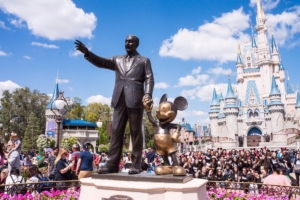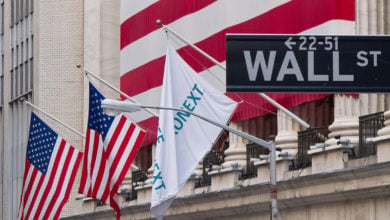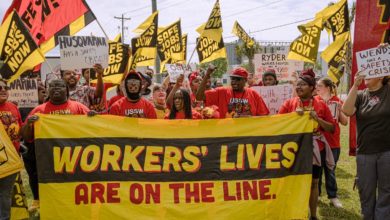(Part one of the article series can be read here.)

As reported here on October 14, Disneyland workers celebrated a huge triumph for labor in September when they voted for a contract that significantly improved their situation in terms of pay, safety, and workplace rights. They managed to secure an important victory not just for themselves and their families, but for workers across the nation. Their conditions before they won the new contract, and the work they had to undertake to overcome the resistance of their antagonistic employer, have great similarities with struggles workers are facing all around the U.S.
Low wages connect with every other issue in life. Firstly, the combination of low wages and inflation is a killer. The official statistics for the Anaheim area (where Disneyland is located in California) show that over the fiscal year ending August 2018, the cost of housing increased 5.1 percent and the cost of transportation went up 8.2 percent (the cost of gas alone by 21.4 percent) and household gas and electric increased by 12.9 percent (the price of natural gas went up 21 percent).
The average real wage at Disneyland in Anaheim (taking inflation into account) dropped by 15 percent from 2000 to 2017, while costs for basic essentials like housing, health care, food and transportation/gasoline soared.
In a study done in February 2018, ten percent of the workers reported being homeless at some point in the last two years, and over fifty percent reported being regularly worried about eviction.
A number of workers who have been homeless while employed by Disneyland spoke out about their conditions during the campaign.
One person who tragically cannot speak out is Yeweinishet “Weini” Mesfin. She was 61 years old when she died in her car, probably at some point in November 2016. Her body was found on December 19 that year. She had been living in her Honda Civic for seven years, while working at Disney on the third shift, cleaning restrooms. As an immigrant from Eritrea, a country destabilized by imperial powers and civil war, she had known difficult times, but she tried to keep them to herself.
She worked at Disney for nine years in a county where the National Low-Income Housing Coalition says it takes a wage of $28.71 per hour to afford a one-bedroom apartment. Disney paid her less than half of that. (In 2016 in Orange County, over 200 homeless people died on the street, in the riverbed, or in a car, according to the county coroner).
Billie Taylor, age 59, has worked for Disney for five years. Her $11.50 an hour wage is so low that she qualified for food stamps. When she had to pay for car repairs, she lost her apartment because she could not afford to pay the rent. She had to move in with others.
Billie Taylor is not alone. The study showed that about 75 percent of workers said that they do not have enough money to pay all of their basic expenses each month. They are constantly on the edge, constantly juggling between basic necessities.
Glynndana Shevlin-Sanchez has worked at Disney for 30 years. She is a food and beverage concierge at the Disneyland Hotel. After 30 years’ service, she only makes $15.70 per hour. She found it impossible to keep up with the rent and became homeless. Her determination to make a change was reflected in her consistent efforts to mobilize her co-workers to come out to actions. She showed her awareness that her fate was bound up with others as she helped organize workers outside of Disney and in her participation in many local coalitions.
Who were the workers fighting?
Disney is an empire. The parks and resorts are a major component of its revenue and profit. In the three months ending June 30, parks and resorts brought in $5.2 billion, and showed an increase of 15 percent in operating income throughout 2017. That is higher than the income from their studios, consumer products and interactive media.
Disney also owns or controls significant parts of theme parks in Paris, Shanghai and Hong Kong. It licenses other parks like one in Japan.
The parks are second in revenue only to the networks that Disney owns, like ABC and ESPN. It has major stakes in A&E TV Networks, Hulu, and Fusion Media (which it owns jointly with Univision). There is also a Disney TV station in Germany, and another operation in Spain. It has its hands in Indiam, where it owns UTV Software Communications.
Disney owns its own movie studios and owns Pixar, Lucasfilm and Marvel Entertainment.
It sells consumer Disney branded goods and owns the Disney cruise line. Disney companies also sell Disney vacations.
But that’s not all. In June, the U.S. Department of Justice gave its approval to Disney’s $71 billion acquisition of 21st Century Fox Inc. assets, minus Fox’s sports network. In essence, the Trump administration OK’d the merger of the two largest U.S. largest entertainment conglomerates, further narrowing down the number of companies that own the majority of U.S. media outlets. (In the same month, AT&T completed its acquisition of Time Warner. AT&T had already taken over DirecTV)
That meant that in the midst of bargaining, Disney was telling low-wage workers that the company could not afford to say ‘yes’ to modest wage demands, while at the same time they were spending billions to increase their monopoly share of world markets. Disney’s economic power is more concentrated than it has ever been.
In another parallel process, just as this bargaining process was ending, on Sept. 22, Comcast beat out Fox to takeover the giant Sky telecom company. That company is based in Britain but has operations in the UK, Ireland, Germany, Austria, Italy, and Spain. It is Europe’s biggest media company. Sky is now set to become an asset of Comcast, which also owns NBC and a portion of MGM.
This is an indication that workers throughout the industry have to face increasingly concentrated power, while the communities impacted by these monopolies have to do the same for basic phone, internet, cable, TV and entertainment.
The Disney workers were up against gigantic monopoly power.
The banks
The Disney Board of Directors is led by a representative of finance capital (Carlyle Group), deeply tied to the military industrial complex. It is also home to representatives from General Motors, MasterCard, and Oracle. However, the real powers behind the throne are the banks and financial institutions.
Financial institutions own over 65 percent of Disney. Just five of them control nearly 20 percent of the company, or enough to set the direction as a unified block (Vanguard, State Street, BlackRock, State Farm, FMR, etc.). This concentration of financial power is at the heart of the resistance workers had to contend with in bargaining.
The political establishment and the media
Disney understands the importance of being a player in the political arena. It’s highly important for profits and power.
It has benefited greatly from a political system captured by corporate interests that puts profits before people. Since WWII, it has helped the U.S. government in its effort to portray the U.S. in glowing and idealized terms.
The role of the state in the area of taxes is revealing. Cities, counties and the state need funds for health care, education, housing, transportation, social services and emergency services. Yet they are kept from having those funds because the tax structure benefits the rich and their corporations. Because of California’s 1978 Proposition 13 constitutional amendment, Disney pays 5 cents per square foot in property taxes, while the average homeowner pays 40 cents. Long established corporations (like Chevron, which saves $100 million per year thanks to this provision) get rich, while impoverished communities can’t access basic services.
Anaheim
For years, Disney has controlled the majority of the City Council in Anaheim, and has played a major role in Orange County political affairs. The web of connections to funding organizations was recently exposed by the Los Angeles Times.
Their November 3, 2017, exposé revealed that Disney had barred its reporters from advance film screenings. That action was taken shortly after previous exposés in September 2017. LA Times management bowed to Disney, and warned the journalists against giving any public praise for the story. That in turn fired up the union organizing drive at the Times. On Jan. 19, writers at the LA Times voted overwhelmingly for the union (248 out of 298). On the same day the publisher of the article was put on an unpaid leave. (Five months later the New Yorker’s editorial staff voted to unionize.)
Florida
From the early 1960s, when Disney used dummy corporations to buy Florida land twice the size of Manhattan, to the mid-1960s when the Orlando operation came out into the open, politics were paramount. In May 1967, the Governor signed a set of laws that gave the OK for Disney to set up not just a company town, but a virtual company county.
The cities of Reedy Creek, Bay Lake, Lake Buena Vista, and the overall Reedy Creek Improvement District were all created specifically for Disney to control completely.
Essentially, the state government gave permission for Disney to create a fiefdom which remains today, where both the apparatus of the governing structure and everything else is privatized, serving the interests of Disney.
The Reedy Creek Improvement District gets tax free bonds to finance Disney operations. The governance of the District is based on elections, but the only people allowed to vote are landholders, and the only landholder is Disney. The people representing Disney on the boards may live in the area, but Disney can evict them at will. Within this District are company towns, like Bay Lake and Celebration. The District itself has always been more white, demographically, than surrounding jurisdictions.
Walt Disney’s vision of “Tomorrowland” embodied in his idea for the Epcot Themepark and brought to life in part by the Reedy Creek District, shows its real right-wing character. All employees are non-union, rent their dwellings from Disney and can be evicted at any time.
Fast forward to 2012
In September 2012 after 50,000 people in Orange County, Florida, signed a petition to get the right to paid sick leave on the ballot, Disney and restaurant giant Darden jumped into action. Their lobbyists sat in the audience texting County Commissioners, who then voted to keep it off the ballot. One Republican leader texted a Commissioner to make sure to defeat the measure so that the state legislature could then deliver a “kill shot.”
This “kill shot” was designed to counter the growing peoples’ movement to win paid sick leave. It had been won in Puerto Rico in 1998, in San Francisco and Connecticut in 2011, and it was on the move to win in New York City, Philadelphia, D.C., and elsewhere. The powers-that-be wanted to nip it in the bud. For them it was and is a matter of power — stopping the growing movement for workers’ power and autonomy that is expressed in these struggles. That is why Comcast spent over $100,000 to fight against paid sick leave in Philadelphia, despite agreeing to it in union contracts.
In June 2013, Florida Governor Rick Scott signed a law banning cities and counties from passing paid sick leave rights (the famous “kill shot”). He knew exactly what the rich and powerful wanted him to do. He is one of them, after all, and shares their perspective. He was rewarded by Disney in the next Governor’s race. In 2015, they gave at least $252,000 to Scott, even more than U.S. Sugar and Florida Power & Light. But they also make indirect contributions. For example, Disney operates through the Florida Chamber of Commerce (where they hold a board seat), which in 2015 gave $925,000 to Scott. Then there is the “dark money,” which under Florida law does not have to list its source, if funneled through another organization.
In the last 22 years, Disney has given out over $38 million to candidates, both Republican and Democrat, in order to keep workers down, to get tax breaks for the corporation, and to expand its profits through many schemes.
While $38 million may seem like a lot, it is viewed by the executives as a mere investment. Since 2000, Disney has received $859,182,037 in subsidies and tax breaks. That doesn’t even count the value for Disney of laws, rules, regulations, agencies and governmental structures that repress or frustrate the exercise of worker rights.
In 2018, during the contract battle, Disney contributed heavily to Adam Putnam, the Republican candidate who appeared set to succeed Scott. Over the last three years, Disney has given him around $1 million. Their plans had to take a detour when Trump supporter Ron Desantis won the primary on August 28. So on Sept. 27, the Chamber of Commerce endorsed the even more reactionary Desantis. In doing so they joined other financial backers of Desantis, such as Koch Industries, Northrup Grumman, American Bankers Association, AT&T, and the U.S. Navy.
Disney knows how to work a political system that is structured to work for the benefit of capital and against labor. The example of paid sick leave and their larger statewide political strategy shows that the Disney workers were also up against the political establishment.
The front office boys
Bob Iger is the CEO. Although most stockholders voted against his compensation package in March 2018, the Board overruled them. His compensation is now set so that he will “earn” up to $48.5 million per year for four years, plus an extra grant of $100 million. One analysis of the deal said that he could earn $423 million during that four year period.
Contrast that to the pay for the workers, without whom Disney would not make a penny.





